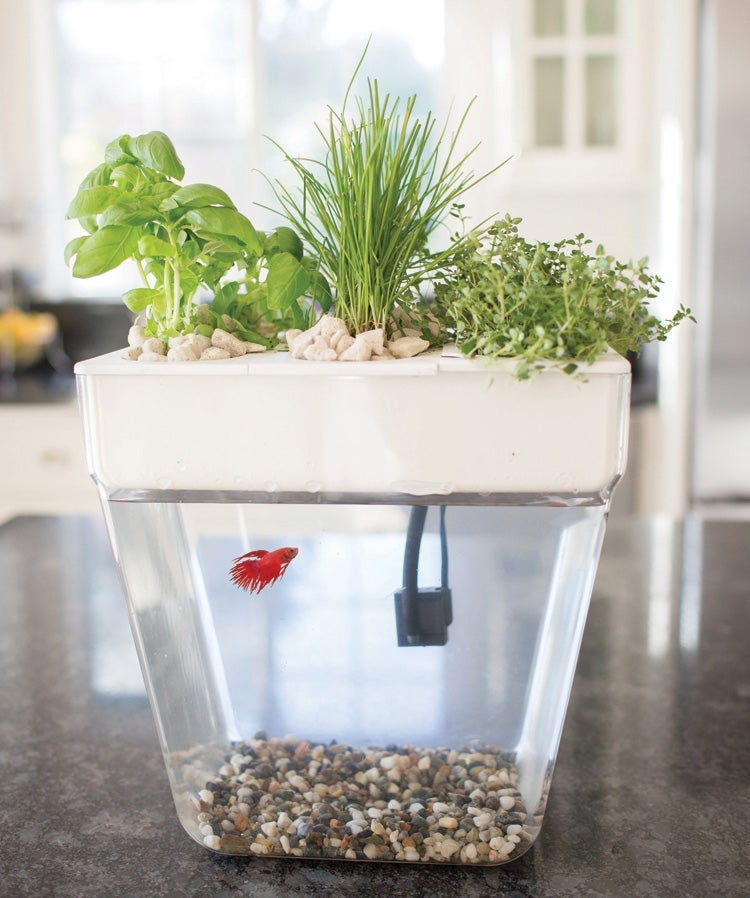Age of Aquariums

Maintaining Your Personal Fish Tank Garden
For centuries, farmers have cultivated plants with aquaponic systems. Since at least 11,000 B.C.E, in China, rice has been grown in paddies. When the fields are flooded, fish come in. Ducks also arrive to enjoy the wetlands. The fish and fowl waste feed the plants, and the plants keep the water clean. When the paddies are drained for harvest, the fish are easy prey, and they too are harvested.
In South America, the second-century Aztecs learned to build chinampas: a series of rectangular raised beds created in Lake Texcoco’s shallow waters. A system of canals between the beds irrigated the plants and provided access by canoe to care for them. Plants flourished in the nutrient-rich lake water, making it possible to harvest at least seven full crops a year.
Now, this time-honored symbiotic growing technique is making the leap from commercial agriculture to homeowners. Instead of vast flooded fields or acres of floating gardens, manufacturers are making decorative fish tank systems that combine the soothing pleasures of an aquarium with indoor herb, flower, and vegetable gardens.

HOW IT WORKS
This closed-loop, self-cleaning ecosystem frees owners from the necessity of cleaning an aquarium or fertilizing and watering plants. Here’s how it works. Fish waste has high concentrations of ammonia. In streams where the water is continuously running, the waste is flushed away. But in a closed fish tank, the concentrated excretions become toxic to the fish. If you add plants, beneficial bacteria that grow naturally in the potting medium convert the ammonia into nitrates, which fertilize the plants. As the plants continuously take up the nitrate nutrients for growth, they are also cleaning the water for your fish.
Typically, a pump moves the water in the aquarium up to the planting bed, where it continuously flows over the roots. The plant roots take up the nutrients, and the cleaned water runs out through the drainage holes back into the tank.
HOW TO MAINTAIN IT
Maintaining a balanced miniature aquaponic system is easy. When the water level drops due to evaporation and transpiration, top it up with room temperature dechlorinated tap water, maintaining a water level at about one inch from the bottom of the grow bed. According to Tom Sanford of Back to the Roots, an innovative company that sells complete miniature aquaponic kits, it’s not necessary to exchange one-third of the water every month, as is recommended for an aquarium system that is not being purified by plants.
Back to the Roots
Back to the Roots is a California-based company with the goal to help families get back to the roots of growing and eating organic, nutritious, and pure food. Founders Alejandro Velez and Nikhil Arora have grown the business to include accessible aquaponic kits, mushroom farms, garden kits, and self-watering planters.
www.backtotheroots.com
Age of Aquariums
Photography provided by www.backtotheroots.com.
Feed your fish daily, but only as much as they will eat in about five minutes. Otherwise, uneaten food will rot at the bottom of the tank. Don’t be overzealous about washing the grow stones. The beneficial bacteria that grow on them are key to the process of converting ammonia to nourishing nitrogen.
HOW TO SIZE IT
Depending on the size of your system, you can grow anything from microgreens such as radish sprouts and wheatgrass to something much larger, such as a braided Japanese money tree (Pachira aquatic). The important thing is to have a balance between the volume of fish waste and plants. The more fish you have, the more plants you’ll need. The goal is to have all the fish excretions taken up as nutrients for the plants. If you purchase a kit, follow the manufacturer’s recommendation for the ratio of water volume to fish and to plants.
A number of companies offer kits that come with everything you need to get started. The Back to the Roots kit comes with a 3-gallon fish tank and gravel, a submersible water pump, the plant bed, organic seeds and grow stones, natural fertilizer (to jump-start the process), fish food, and a coupon for a betta fish. Fin to Flower Aquaponics offers several size options and configurations ranging from a 2.5-gallon tank with three, two-inch grow pots to a 5-gallon tank with two planting tiers, which each hold three, three-inch grow pots. These systems each include a waterfall that returns the circulated water back to the tank aerates the water and is visually appealing. Check online to learn more about the many options available on the market.
A home aquaponic system combines the pleasure of tropical fish with the fun of growing plants indoors. You’ll have no weeding, no soil pests, and no watering. It is a great project for the entire family.
WRITTEN BY CATRIONA TUDOR ERLER